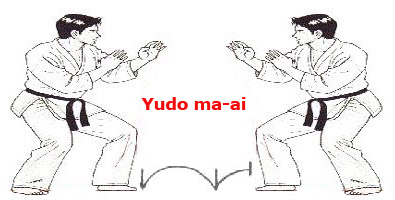CLOSE RANGE : So-ou-mai-ai (one step)

With Distance, we generally mean the Distance between you and your opponent; however, it is also used in a more limited sense to indicate the distance at which it is easiest to counter your opponent's moves and launch attacks.
To get a clearer idea of the term, imagine a fight using weapons such as a spear, sword or knife. Just as you would have to alter your methods of attack to suit each weapon, so you must also vary the distance between yourself and your opponent.
At close range, a take down is preferred. And whilst there are a variety of trips and sweeps employed for getting the man down, once he is down he is finished off with punches and stomps. At a medium range, the adept makes use of shorter kicks and longer punches. At long range, the emphasis shifts to roundhouse kicks and evasive and gap closing counters.
CLOSE RANGE : So-ou-mai-ai (one step)

MIDDLE RANGE : Yudo-mai-ai (one and a half steps)

LONG RANGE : Gendo-mai-ai (two steps)

JUDGING DISTANCE
In order to keep the proper distance, you have to be
able to read your opponent's moves. For example, the impact point differs
for a roundhouse kick, a punch, or an elbow strike. Going back to the weapons
analogy: you need different distances for a spear, sword, or knife.
In judging distance, you must watch your opponent and
move your feet accordingly, always shifting your body away from the danger
zone.
It is of utmost importance that you constantly think
about the Mai-ai. Indiscriminate or un-thinking attacks will only lead
to wasted movement and possibly loss of the fight.
 Return
to Home Page
Return
to Home Page